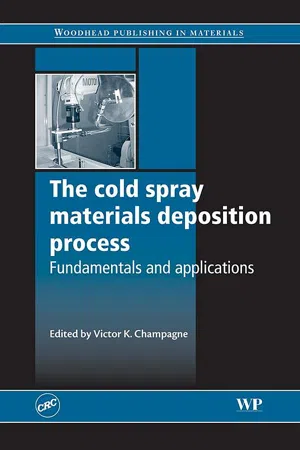Cold spray is a process whereby metal powder particles are utilized to form a coating by means of ballistic impingement upon a suitable substrate.1–3 The metal powders range in particle size from 5 to 100 µm and are accelerated by injection into a high-velocity stream of gas. The high-velocity gas stream is generated through the expansion of a pressurized, preheated gas through a converging–diverging nozzle. The pressurized gas is expanded to supersonic velocity, with an accompanying decrease in pressure and temperature.4–6 The powder particles, initially carried by a separate gas stream, are injected into the nozzle either prior to the throat or downstream of the throat. The particles are then accelerated by the main nozzle gas flow and are impacted onto a substrate after exiting the nozzle. Upon impact, the solid particles deform and create a bond with the substrate.7,8 As the process continues, particles continue to impact the substrate and form bonds with the deposited material, resulting in a uniform coating with very little porosity and high bond strength. The term ‘cold spray’ has been used to describe this process due to the relatively low temperatures (–100 to +100 °C) of the expanded gas stream that exits the nozzle.
Cold spray as a coating technology was initially developed in the mid-1980s at the Institute for Theoretical and Applied Mechanics of the Siberian Division of the Russian Academy of Science in Novosibirsk.9 The Russian scientists successfully deposited a wide range of pure metals, metallic alloys, polymers, and composites onto a variety of substrate materials, and they demonstrated that very high coating deposition rates are attainable using the cold spray process. These experiments are described in detail in Chapter 2. Currently, a variety of cold spray research is being conducted at institutions in dozens of locations world-wide.
The temperature of the gas stream is always below the melting point of the particulate material during cold spray, and the resultant coating and/or freestanding structure is formed in the solid state. Since adhesion of the metal powder to the substrate, as well as the cohesion of the deposited material, is accomplished in the solid state, the characteristics of the cold spray deposit are quite unique in many regards. Because particle oxidation is avoided, cold spray produces coatings that are more durable with better bond strength. The exceptional adhesion of cold spray coatings is in part due to the low temperatures at which the coatings are deposited. One of the most deleterious effects of depositing coatings at high temperatures is the residual stress that develops, especially at the substrate–coating interface. These stresses often cause debonding. This problem is compounded when the substrate material is different from the coating material. This problem is minimized or eliminated when cold spray is used. In addition, interfacial instability due to differing viscosities and the resulting roll-ups and vortices promote interfacial bonding by increasing the interfacial area, giving rise to material mixing at the interface and providing mechanical interlocking between the two materials.
A key concept in cold spray operation is that of critical velocity.10,11 The critical velocity for a given powder is the velocity that an individual particle must attain in order to deposit (or adhere) after impact with the substrate. Small particles achieve higher velocities than do larger particles, and, since powders contain a mixture of particles of various diameters, some fraction of the powder is deposited while the remainder bounces off. The weight fraction of powder that is deposited divided by the total powder used is called the deposition efficiency. High velocity is necessary for optimal deposition efficiency and packing density, and several parameters – including gas conditions, particle characteristics, and nozzle geometry – affect particle velocity. Chapters 7 through 10 consider the effects of these parameters in detail.
The two principal cold spray system configurations differ in the location of powder injection into the nozzle, and these systems are described in more detail in Chapters 11 and 12. The two configurations are depicted by Figs 1.1 and 1.2. Figure 1.1 shows a system in which the main gas stream and the powder stream are both introduced into the mixing chamber of the converging–diverging nozzle. This configuration requires that the powder feeder be capable of high gas pressure and is most often used in stationary cold spray systems, for which the cumbersome powder feeder is acceptable. Figure 1.2 shows a system in which the powder stream is injected into the nozzle at a point downstrea...
